World conservation is more important than ever before, due to the growing concern over the impacts of human activity on the environment. Climate change, deforestation, habitat destruction, and pollution are just a few of the pressing environmental issues that the world faces. The loss of biodiversity and natural habitat threatens the survival of many plant and animal species that are essential to human life. Conservation efforts play a crucial role in preserving ecosystems, protecting natural resources, and mitigating the negative impact of human activities on the environment.
Here’s where green supply chain management practices come in to manage the environmental impact of the supply chain .In this blog, we will discuss about
- Importance of World Conservation
- Ways to help the planet towards conservation
- Role of green supply chain management in conservation
- Balancing conservation and business
Table of Contents
ToggleImportance of Green Supply Chain Management in World Conservation
Ever increasing consumer needs and the ability of human beings to constantly innovate and build at scale without consideration to the environment has led to an adverse impact on the ecosystem. This is glaringly apparent with the rise in the natural disasters and hazards that put the future of our existence in peril and we will see increasing deforestation, global warming, soil erosion, pollution, degradation of the ecosystem, extinction of species and desertification.
The loss of forests could mean reduction in carbon sinks that could accelerate the climate change. The Amazon used to sink 5 percent of carbon emissions but it is no longer the case now. In the first half of 2022 alone, 1500 square miles of Amazon Forest was destroyed – this is twice the size of Beijing. More than 75% of food crops depend on animal pollination but over 40% of insects species have been lost over the past decade. Between 2015 and 2020, the rate of deforestation was estimated at 10 million hectares per year – an area the size of Iceland. And such losses in biodiversity would have a direct impact on our economies and development. Malaysia one of the most biodiverse countries in the world could suffer 6% loss in GDP by 2030 due to the threats to nature and biodiversity.
Hence conserving nature is not a charitable activity rather it is crucial to preserve the economic well-being on which our lives depend. The Nature Conservancy along with the University of Minnesota and 11 other institutions made a study on the projected growth in population and the increase in demand by 2050 which helps us rethink the way we should be doing business.

Organizational shift towards Conservation with Green Supply Chain Management
The scale of challenges that our planet faces could seem daunting but we all can play a part in doing something towards its preservation and betterment. Here are some of the ways organizations can play a role in world conservation.
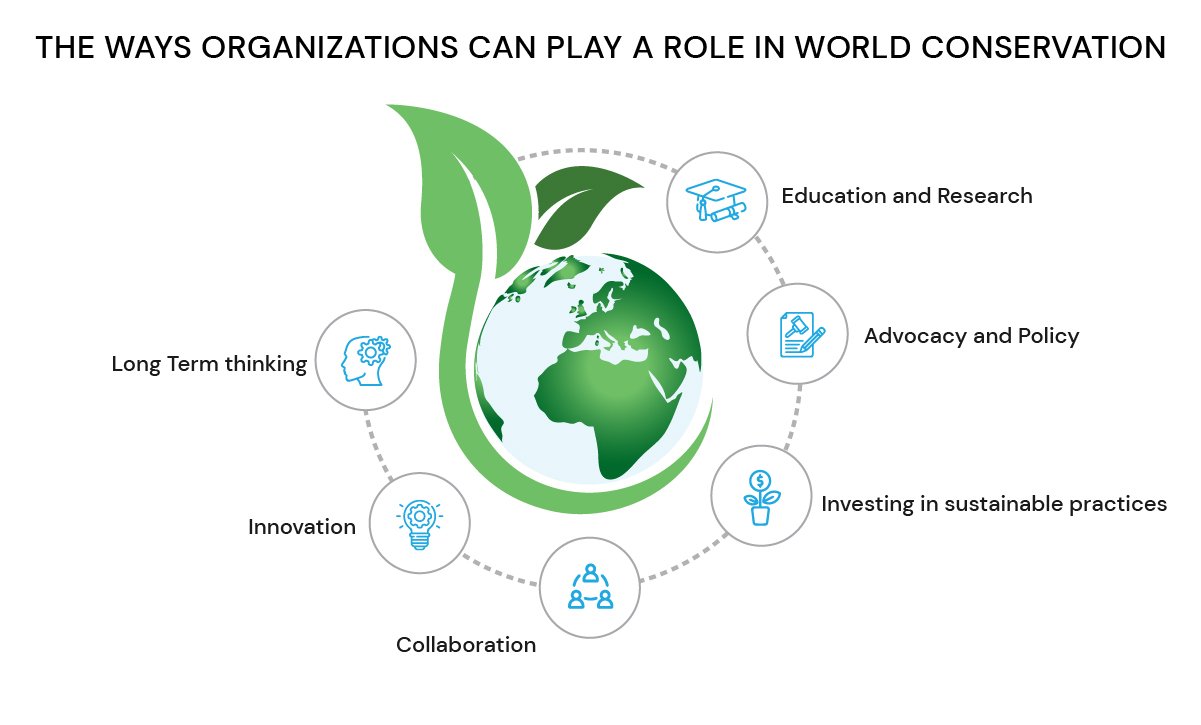
- Education and Research: Organizations play a key role in raising awareness of environmental threats, challenges, and their impact. The shift in priorities towards sustainability and conservation is the foremost trait needed in our race toward protecting the planet. Organizations can fund research on green supply chain options and ecosystems to better understand their needs and develop effective conservation strategies.
- Advocacy and Policy: Organizations can advocate for stronger environmental policies and regulations and engage in policy development to ensure that decision-making incorporates conservation. This can help create a framework for conservation efforts, by setting regulations, standards, and incentives that encourage conservation practices.
- Sustainability: Organizations can adopt sustainable practices in their operations, such as reducing waste and emissions, using renewable energy, and sourcing sustainable materials.
- Collaboration: Organizations can come together to reach a broader audience and increase public engagement toward world conservation. Organizations can share resources, knowledge and prioritize their focus on more complex conservation challenges and arrive at best practices. Collaboration can help ensure that conservation efforts are coordinated, efficient and have long lasting results.
- Innovation: Organizations need to be innovative and adaptable, constantly seeking new approaches and technologies to tackle conservation challenges. This includes embracing new technologies, such as satellite imagery and drones, to monitor and protect natural resources, as well as new approaches to engaging local communities in conservation efforts.
- Long term thinking: Finally, conservation efforts need to take a long-term view, recognizing that the protection of natural resources is critical for the well-being of current and future generations. This means thinking beyond short-term gains and prioritizing the long-term health of the planet.
A look at the 2050 impact model depicted in the infographic below clearly shows that we can no longer be business as usual rather the key would be to make the organizational changes soon. These changes can help achieve a more sustainable future for the 10 billion people and millions of other life forms that call Earth as their home.
Source : WorldEconomicForum
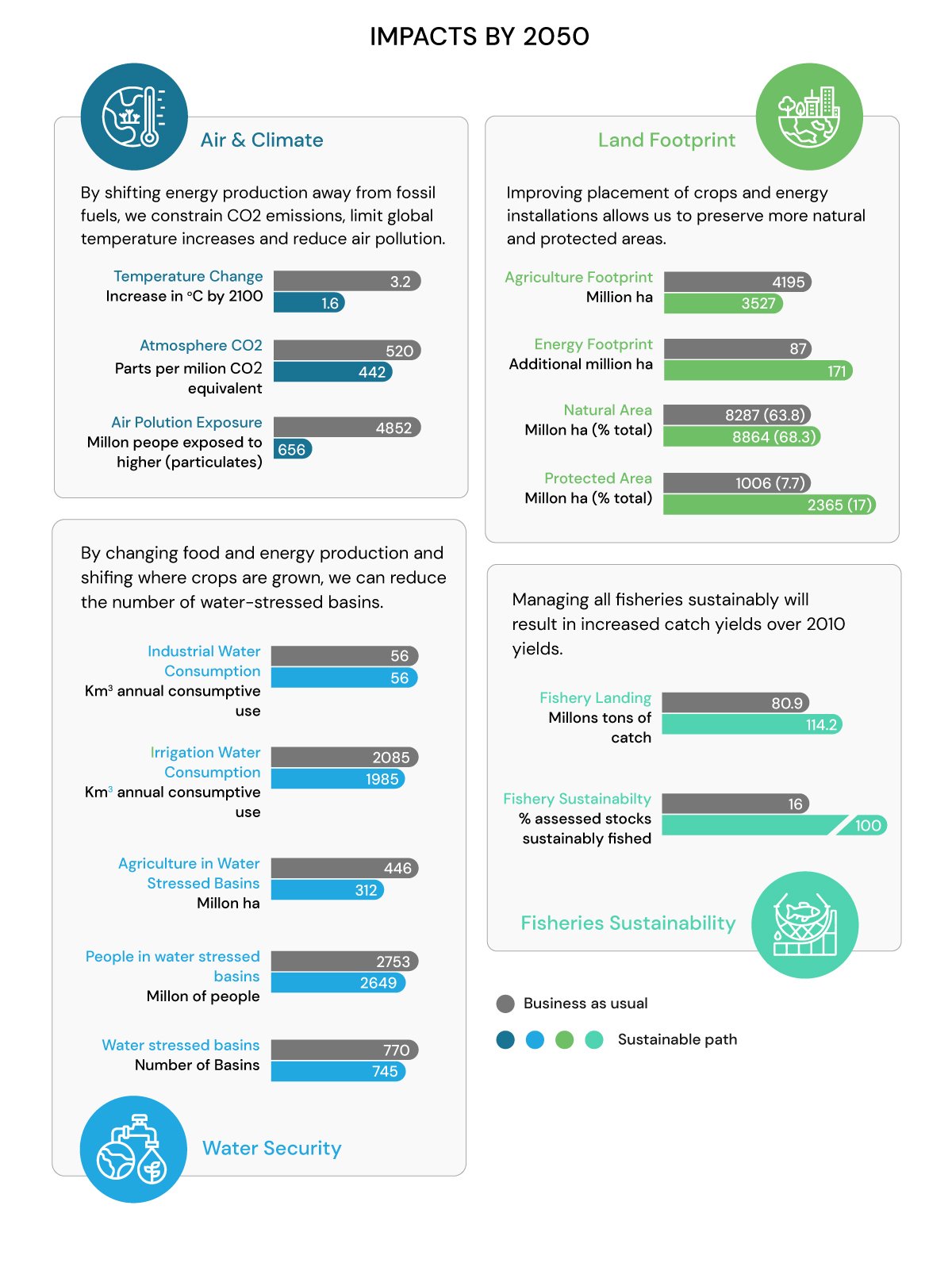
Role of Green Supply Chain in Conservation Efforts
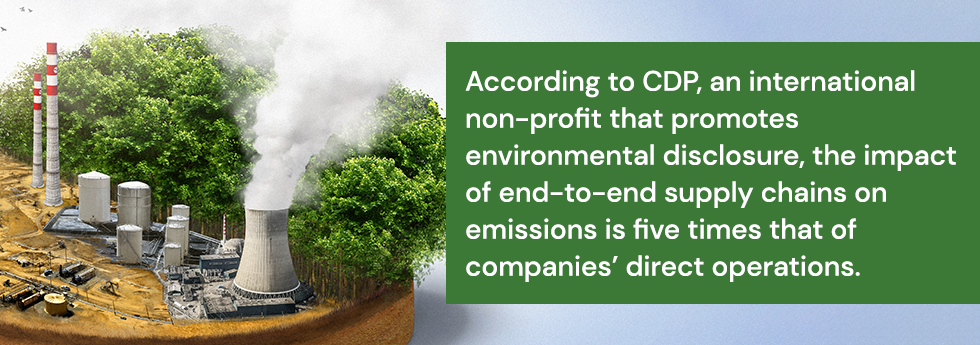
With the ever-increasing population on one hand and the demand for goods and services on the other, supply chain is at the forefront placed in a unique position to address sustainability concerns like deforestation, carbon emissions, pollution, green gases and plastic usage. Procurement has huge buying power and the ability to decide what to buy and from whom to buy thereby gaining the power to promote sustainable environment friendly practices. “According to CDP, an international non-profit that promotes environmental disclosure, the impact of end-to-end supply chains on emissions is five times that of companies’ direct operations.”
Here are some of the ways for Supply Chain / procurement can drive sustainability and conservation efforts.
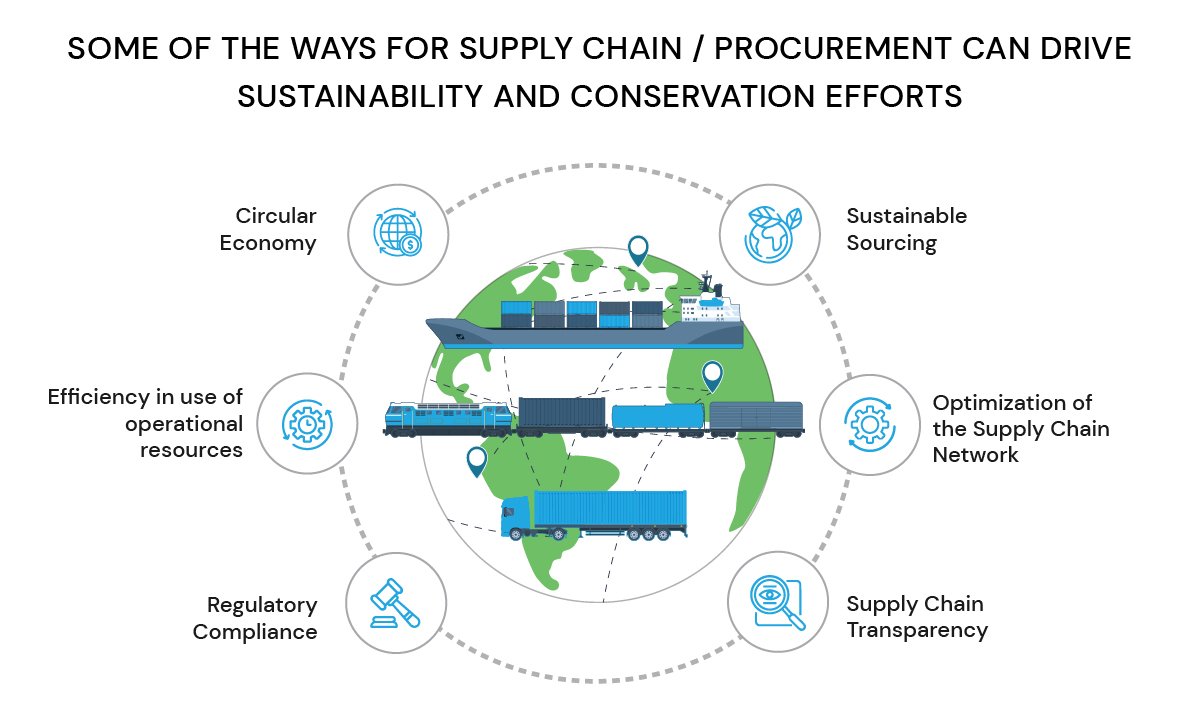
- Sustainable Sourcing: By sourcing raw materials from sustainable sources, companies can reduce the environmental impact of their supply chain. This includes sourcing materials from suppliers that use environmentally friendly practices, such as such as renewable energy, energy recovery, water conservation etc.
- Supply Chain Transparency: Identifying where the products come from and how they are being produced will help to identify the possible environmental risks and arrive at measures to reduce the impact. Transparency can incentivize suppliers to adopt more sustainable practices as they constantly feel the pressure to meet their customers’ environmental standards.
- Optimization of the Supply Chain Network: The goal of optimizing the supply chain network for sustainability is to create a more efficient, resilient, and responsible supply chain. By assessing environmental, social and economic impacts, adopting green logistics, using sustainable materials, engaging suppliers and stakeholders, and monitoring progress, companies can create a more sustainable and responsible supply chain that contributes to broader conservation goals.
- Circular Economy: In a circular economy, products are designed for durability, repairability, and recyclability, and materials are reused and recycled to minimize waste and conserve resources. A circular economy encourages innovation by promoting the development of new technologies, products, and business models that support sustainability and conservation efforts.
- Efficiency in use of operational resources: Introducing advanced analytics to enable more robust planning and scheduling that can improve productivity and diminish the environmental footprint.
- Regulatory Compliance: Regulations like LkSG, EU CSRD, EU Green Deal, Sustainability reporting standards create a framework for organizations to follow and encourage them to go beyond the minimum requirements and strive for more sustainable practices.
Balancing Conservation and Business
Balancing conservation and supply chain efforts requires a green supply chain management approach that considers the environmental impact of the supply chain and promotes sustainability while also ensuring efficient and cost-effective operations. This includes locating critical issues across the whole supply chain, linking the company’s supply chain goals with sustainability goals and helping suppliers manage the impact and reporting it.
Locating Critical Issues across Supply Chain
- The first step would be to identify areas of the supply chain where sustainability improvements can be made, such as reducing greenhouse gas emissions, water consumption, and waste generation. Information on direct and indirect suppliers, their activities and sustainability aspects are important to determine the actual and potential environmental impacts.
- On the basis of the identification of sustainability aspects, a company can assess and prioritise corrective actions on the negative impact on environment. It may not be possible for a company to focus on all sustainability impacts simultaneously hence prioritising where the greatest risk for negative impacts on environment can occur is the most viable approach.
- These risks need to be translated to topics and action areas that the company needs to focus on in order to optimise and develop a sustainable supply chain.
Link Supply Chain Goals with Sustainability goals
- Offer a clear vision and narrative on how sustainability goals will be embedded into the company’s overall vision and goals.
- Set clear goals and measurement practices to ensure accountability amongst everyone involved in the supply chain. This might also mean imparting training on how to identify environmental risks in the supply chain.
- Adopt a framework to measure the performance against your sustainability goals. We have many regulations and frameworks like the Sustainability Accounting Standards Board, CDP, EU CSRD or LkSG.
Evaluate Sustainability Performance of Suppliers
It is also important to get the suppliers onboard with the company’s sustainability goals hence formulating a code of conduct, establishing audit process for suppliers, defining sustainability performance criteria for suppliers, developing and providing training for suppliers, consolidating the pool of suppliers to minimize risk is necessary.
- Establish clear criteria for evaluating supplier sustainability performance. This may include factors such as environmental impact, labour standards, social responsibility, and ethical practices. Ensure that these criteria are aligned with your company’s sustainability goals.
- Provide a code of conduct to the suppliers in the supply chain and make it binding by integrating it into the supplier contract
- Collect data on supplier sustainability performance. This can be done through surveys, site visits, and audits. You can also ask for sustainability reports and certifications from suppliers.
- Analyse the data collected from suppliers to evaluate their sustainability performance. Look for areas where suppliers are excelling and where they need to improve. You can use tools such as sustainability scorecards and metrics to make this evaluation easier.
- Provide feedback to suppliers on their sustainability performance. Discuss areas where they are doing well and where they need to improve. Develop supplier capabilities to enhance their sustainability performance by providing resources or introducing pilot projects on environmental aspects.
- Continuously monitor supplier sustainability performance to ensure that they are meeting the sustainability criteria.
Reporting
To meet the demand for information on responsibility and sustainability, companies should provide sustainability reports. Disclosure of environmental risks /impacts along the supply chain, supplier performance in the risk analysis process, audit data, implementation of measures and actions taken against it all need to be part of the reporting process. Review the reports to understand how you have performed and use it as a baseline to set new benchmarks and goals on areas where there is scope for improvement.
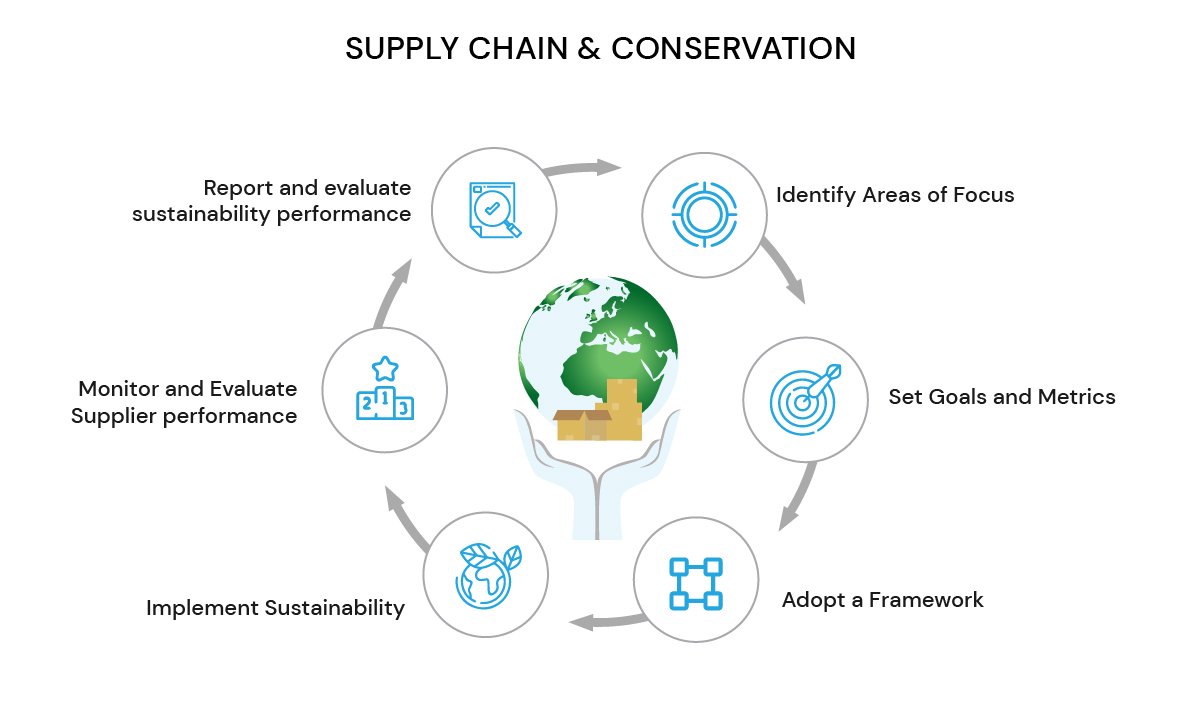
Driving conservation efforts is a continuous process. While driving conservation efforts through the supply chain is a long way to go, it is essential to take meaningful action to reduce environmental impact and achieve global sustainability goals.
Call for Action – Towards a Better Future
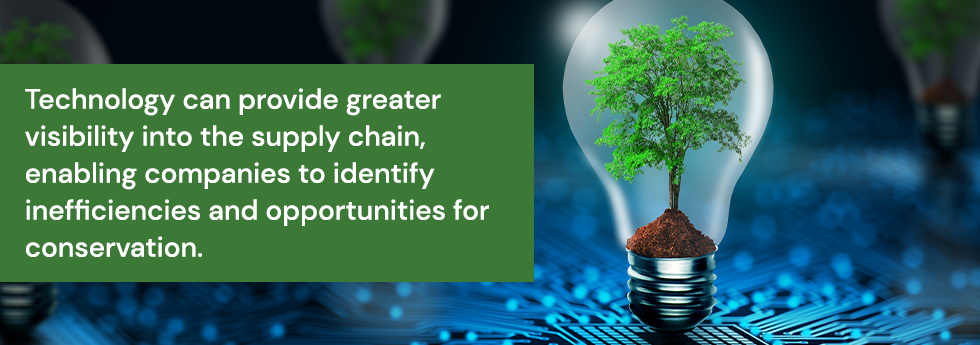
Balancing the nature and the human demands can be quite daunting. But it is not an either-or proposition. Many companies face obstacles such as supply chain complexity, lack of visibility, limited resources, and varying regulatory frameworks that hinder their ability to implement sustainable practices across the entire supply chain. With the technological advancement we have it is quite possible to manage complex supply chains, select sustainable suppliers, evaluate their performance, assess threats early and mitigate impacts/ risks to the environment. Technology can provide greater visibility into the supply chain, enabling companies to identify inefficiencies and opportunities for conservation. Real-time monitoring and tracking of supply chain processes can help companies reduce waste, minimize environmental impact, and increase efficiency. Analytics can help companies to optimize supply chain resources and make more informed decisions and identify areas where conservation efforts can be more effective. Choosing the right technology/solution can help you stay compliant, improve accountability and responsibility towards world conservation, gain consumer confidence, stay ahead of the competition and thus conserving the planet for the generations to come.
MeRLIN’s supply chain due-diligence act solution enables you to integrate responsible sourcing practices across the supplier ecosystem for ensuring compliance. The supplier management solution will help you assess the suppliers, segment them based on risks, analyse their performance. MeRLIN’s Strategic software sourcing solution comes with comprehensive features such as ability to issue policy statements, conduct supplier surveys, maintain a risk register, facilitate in-person audits, retrieve and analyse custom reports for compliance and more allowing businesses to drive efforts for green supply chain management.



